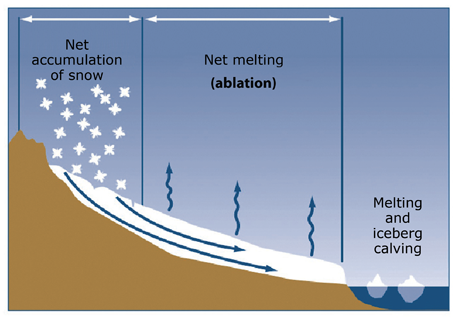Previously I’ve told you a bit about the formation of the Laurentide ice sheet, the ice sheet that covered a large part of North America in the last ice age. However, since there obviously isn't a glacier there now, the great Laurentide has long since retreated. The ice sheet began to retreat around 20,000 years ago. By 18,000 years ago, it was gone from the region between Cape Cod to the Maine coast. Then, by 15,000 years ago, it has retreated from all of southern New England and the Gulf of Maine. 9,000 years ago all that was left of the Laurentide was an area in Quebec and Labrador with a size similar to Greenland.
 |
| How the Laurentide shrank over time as the climate warmed. |
Something that I have found interesting is how scientists have managed to calculate the rate of retreat of this glacier. Afterall, it was long gone by the time we ever got around to studying it. Basically, geologist have used radiocarbon and surface exposure dating techniques to determine the time at which the glacier left that area. Then they found the distance that location was from the starting point. By using the distance and age, they could figure out the speed by simple using distance divided by time (Ullman).
West Quebec: 700-900 meters/year
Central Quebec: 300 meters/year
East Quebec: 150 meters/year
From this data it is clear that the ice sheet did not move at a constant rate. It moved at a much faster rate in the west and was significantly slower in the east. This could be because in order for the glacier to advance and grow if would need more snowfall to counterbalance the melting due to the warmer climate. On the east, the Atlantic Ocean provided enough moisture to supply the glacier with adequate snowfall to slow the rate of ablation. On the west, there were no water sourced, so the glacier did not receive as much snow to slow the melting.
 |
| A glacier grows if the accumulation is greater than the ablation. The Laurentide shrank because the ablation was greater than the accumulation. |
Here is a link to a great animation of the Laurentide's retreat.
Have a fantastic day!
Image/Animation Citations:
Laurentide Ice Sheet. CSDMS. University of Colorado, n.d. Web. 25 May 2013. <http://csdms.colorado.edu/wiki/Movie:Laurentide_Ice_Sheet>.
Have a fantastic day!
Image/Animation Citations:
Laurentide Ice Sheet. CSDMS. University of Colorado, n.d. Web. 25 May 2013. <http://csdms.colorado.edu/wiki/Movie:Laurentide_Ice_Sheet>.
Short, N. Laurentide Ice Sheet at circa 14,000 B. Digital image. Recovering the Lost World, A Saturnian Cosmology -- Jno Cook Chapter 9: Event of the Younger Dryas. N.p., 25 Mar. 2013. Web. 25 May 2013. <http://saturniancosmology.org/bin/lauren14kbp.jpg>.
The accumulation and ablation of a glacier. Digital image. USGS. U.S. Department of the Interior, 9 Jan. 2013. Web. 25 May 2013. <http://pubs.usgs.gov/fs/2009/3046/images/fs20093046_fig03.png>.

No comments:
Post a Comment